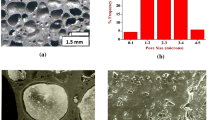Abstract
The bubble generation process in conditioned A356 alloy melt through submerged spiry orifices with a wide diameter range (from 0.07 to 1.0 mm) is investigated in order to prepare aluminum foams with fine pores. The gas flow rate and chamber pressure relationship for each orifice is first determined when blowing gas in atmospheric environment. The effects of chamber pressure (P c) and orifice diameter (D o) on bubble size are then analyzed separately when blowing gas in melt. A three-dimensional fitting curve is obtained illustrating both the influences of orifice diameter and chamber pressure on bubble size based on the experimental data. It is found that the bubble size has a V-shaped relationship with orifice diameter and chamber pressure neighboring the optimized parameter (D o = 0.25 mm, P c = 0.4 MPa). The bubble generation mechanism is proposed based on the Rayleigh–Plesset equation. It is found that the bubbles will not be generated until a threshold pressure difference is reached. The threshold pressure difference is dependent on the orifice diameter, which determines the time span of pre-formation stage and bubble growth stage.











Similar content being viewed by others
Abbreviations
- d b :
-
Bubble size (mm)
- D * :
-
Cell size (mm)
- D o :
-
Orifice diameter (mm)
- f b :
-
Bubble formation frequency (Hz)
- g :
-
Gravitational acceleration (m/s2)
- H :
-
Orifice immersion depth (mm)
- l 1 :
-
Chord length in the horizontal direction (mm)
- l 2 :
-
Chord length in the longitudinal direction (mm)
- P atm :
-
Atmospheric pressure (MPa)
- P b :
-
Bubble pressure (MPa)
- P c :
-
Chamber pressure (MPa)
- P L :
-
Liquid pressure (MPa)
- Q :
-
Gas flow rate at liquid temperature (L/min)
- Q 0 :
-
Gas flow rate at room temperature (L/min)
- Q E :
-
Equivalent gas flow rate in a bubble formation cycle (seconds)
- R :
-
Instantaneous bubble radius (mm)
- T a :
-
Time for pre-formation stage (seconds)
- T b :
-
Bubble formation cycle (seconds)
- δ :
-
Anisotropy ratio
- θ :
-
Contact angle (deg)
- μ :
-
Liquid dynamic viscosity (N s/m2)
- ν :
-
Liquid kinematic viscosity (m2/s)
- ρ :
-
Liquid density (kg/m3)
- σ LG :
-
Liquid–gas surface tension (N/m)
References
Z. Han and L. Holappa: Metall. Mater. Trans. B, 2003, vol. 34, pp.525-32.
Z. Liu, L. Li, F. Qi, B. Li, M. Jiang and F. Tsukihashi: Metall. Mater. Trans. B, 2015, vol. 46, pp. 406-20.
F. García-Moreno, B. Siegel, K. Heim, A. J. Meagher and J. Banhart: Colloid. Surf. A, 2015, vol. 473, pp. 60-7.
Y. P. Jeon, C. G. Kang and S. M. Lee, J: Mater. Process. Tech., 2009, vol. 209, pp. 435-444.
J. Banhart: Prog. Mater. Sci., 2001, vol. 46, pp. 559-632.
L. P. Lefebvre, J. Banhart and D. C. Dunand: Adv. Eng. Mater., 2008, vol. 10, pp. 775-87.
J. Banhart: Adv. Eng. Mater., 2013, vol. 15, pp. 82-111.
F. Dobesberger, H. Flankl, D. Leitlmeier, A. Birgmann, and P. Schulz: US patent, 2007, 7,195,662 B2.
V. V. Slezov: J. Colloid. Interf. Sci., 2002, vol. 255, pp. 274-292.
H. Bo-Young, P. Soo-Han and A. Hiroshi: Mater. Sci. Forum., 2003, vol. 439, pp. 51-6.
D. Gerlach, G. Biswas, F. Durst and V. Kolobaric: Int. J. Heat. Mass. Tran., 2005, vol. 48, pp. 425-38.
M. Jamialahmadi, M. R. Zehtaban, H. Muller-Steinhagen, A. Sarrafi and J. M. Smith: Chem. Eng. Res. Des., 2001, vol. 79, pp. 523-32.
J. Yuan and Y. Li: Sci. Chi. Tech. Sci., 2015, vol. 58, pp. 64-74.
J. Xie, X. Zhu, Q. Liao, H. Wang and Y. Ding: Int. J. Heat. Mass. Tran., 2012, vol. 55, pp. 3205-13.
R. Kumar and N. R. Kuloor: Adv. Chem. Eng., 1970, vol. 8, pp. 255-368.
J. F. Davidson and B. Schüler: Chem. Eng. Res. Des., 1997, vol. 75, pp. S105-15.
E. S. Gaddis and A. Vogelpohl: Chem. Eng. Sci., 1986, vol. 41, pp. 97-105.
M. Sano and K. Mori: Trans. JIM, 1976, vol. 17, pp. 344-52.
J. Yuan, Y. Li and Y. Zhou: J. Mater. Sci., 2014, vol. 49, pp. 8084-94.
S. Ramakrishnan, R. Kumar and N. R. Kuloor: Chem. Eng. Sci., 1969, vol. 24, pp. 731-47.
A. Marmur and E. Rubin: Chem. Eng. Sci., 1976, vol. 31, pp. 453-63.
W. B. Hayes III, B. W. Hardy and C. D. Holland: A.I.Ch.E. J., 1959, vol. 5, pp. 319-24.
H. N. Oguz and A. Prosperetti: J. Fluid. Mech., 1993, vol. 257, pp. 111-45.
S. Gnyloskurenko, A. Byakova, T. Nakamura, and O. Raychenko: J. Mater. Sci., vol. 40, pp. 2437–41.
S. V. Gnyloskurenko and T. Nakamura: Mater. Trans., 2003, vol. 44, pp. 2298-302.
X. Fan, X. Chen, X. Liu, H. Zhang and Y. Li, Metall. Mater. Trans. A, 2013, vol. 44, pp. 729-37.
M. Martín, F. J. Montes and M. A. Galan: Chem. Eng. Sci., 2006, vol. 61, pp. 363-9.
A. A. Kulkarni and J. B. Joshi: Ind. Eng. Chem. Res., 2005, vol. 44, pp. 5873-931.
T. Fourest, J. Laurens, E. Deletombe, J. Dupas, and M. Arrigoni: Int. J. Impact. Eng., 2014, vol. 73, pp. 66–74.
T. G. Leighton, K. J. Fagan and J. E. Field: Euro. J. Phys., 1991, vol. 12, pp. 77-85.
Acknowledgment
This work is supported by the International Cooperation Project of Ministry of Science and Technology of China (Grant No. 2013DFR50330).
Author information
Authors and Affiliations
Corresponding author
Additional information
Manuscript submitted October 20, 2015.
Rights and permissions
About this article
Cite this article
Yuan, J., Li, Y., Wang, N. et al. Effect of Orifice Diameter on Bubble Generation Process in Melt Gas Injection to Prepare Aluminum Foams. Metall Mater Trans B 47, 1649–1660 (2016). https://doi.org/10.1007/s11663-016-0638-5
Published:
Issue Date:
DOI: https://doi.org/10.1007/s11663-016-0638-5




